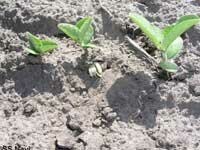
-
Soybean Diseases
- Asian Rust
- Anthracnose
- Bacterial Blight
- Bacterial Pustule
- Bean Pod Mottle Virus
- Brown Stem Rot
- Cercospora Leaf Blight
- Charcoal Rot
- Downy Mildew
- Frogeye Leaf Spot
- Green Stem Syndrome
- Iron Deficiency Chlorosis
- Phytophthora Root & Stem Rot
- Powdery Mildew
- Rhizoctonia
- Seedling Diseases
- Septoria (Brown Spot)
- SCN (Soybean Cyst Nematode)
- Soybean Mosaic Virus
- Stem Canker
- Sudden Death Syndrome
- Viruses
- White Mold
- Soybean Pests
- Diagnostic Help
- Field Trials
- Soybean Library
| Disease: Seedling Diseases |
Your Soybean Checkoff.
Delivering Results.
Illinois
Indiana
Iowa
Kansas
Michigan
Minnesota
Missouri
Nebraska
North Dakota
Ohio
South Dakota
Wisconsin
Soybean Seedling Diseases

|
| Seed and seedling diseases reduce stands in the spring, with severity varying from year to year. Click on image to view a larger version. Photo credit: S.S. Navi, Iowa State Univ |
Seedling health can be compromised by plant pathogenic fungi that cause seed rot, seedling death, and root decay. Seedling-infecting fungi are common in soybean fields.
Poor stands may be the first indication of a pathogen problem. Damping-off, or seedling blight, is a general name for infections that occur underground or at the soil surface, toppling the seedlings at the base.
Seedling problems are usually associated with wet soil conditions, although problems might not be noticed until some time after the wet conditions occurred. Slow germination, slow growth of soybean seedlings, poor quality seed, and plant stress all create favorable conditions for seed and seedling diseases of soybean.
Causal pathogens
Phytophthora sojae, several species of Pythium fungi, and Rhizoctonia solani are the most important seedling pathogens in the north-central states. Plant pathologists at Iowa State University have found that Pythium, Phytophthora, and Rhizoctonia account for nearly 90% of disease-related stand reduction problems in Iowa.
Other plant pathogens actively invade plants from growth stages VE to V4 as well, including Fusarium solani, Mycoleptodiscus terrestris, Macrophomina phaseolina (charcoal rot), Fusarium verguliforme (sudden death syndrome), and Phialophora gregata (brown stem rot). Seedling infection by these pathogens may cause chronic symptoms, or the infection can remain latent and cause premature decline of foliage and stems later in the growing season.
Seedborne fungi
Seedborne pathogens can also affect germination. Seed infected with Phomopsis longicola, Cercospora spp. or Fusarium spp. may rot during the germination or emergence phase.
Plant health assessment is important in the seedling stage
Frequently, seedling health is ignored because plant populations are acceptable and stem and leaves do not express symptoms during early vegetative growth. However, notes taken about plant health in the seedling phase can be used to make adjustments in crop management in subsequent years, and may explain symptoms or less-than-anticipated yield later in the season.
Resources
Soybean Seed Health - Iowa State University (pdf)
Soybean Seedling Health - University of Wisconsin
Fungi associated with soybean seedling disease in Iowa. Rizvi, S.S. A and X.B. Yang. 1996. Plant Disease 80 (1): 57-60 (pdf)
